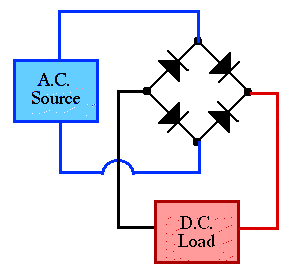
|
Hands-On-Physics
ELECTRICITY
|
Extensions
|
- Ready-Made Extension #3 -
|
Directing Current
The Bridge Rectifier in the LVPS circuit cleverly changes alternating current which changes
direction of flow 60 times into direct current which maintains its flow in one direction.
The bridge rectifier is made from diodes.
The general question of this investigation is "How does a bridge rectifier work?"
The quick answer is: "It uses diodes." Of course that leads to more questions;
what does a diode do, and how are diodes combined to make a rectifier?
Start by investigating diodes.
Begin with a light emitting diode (LED) and find out the effect of voltage on the current
through the diode. Make graphs of current vs voltage. Drive current through the diode
in one direction, slowly increasing the voltage.
Be CAREFUL, the LVPS can easily burn out LEDS; they operate at quite low voltages, so stop
as soon as the LED is nicely lit. Now reverse the leads of the diode and drive current through
in the other direction, slowly increasing the voltage. Combine the two plots of
current vs. voltage on one graph. This is the characteristic curve of the diode.
Four diodes can be connected in a way that lets current pass through a load when the
applied voltage is positive, but reverses polarity when the voltage is negative.
The backward negative current is the same as a positive forward current.
A circuit diagram for this configuration, called a bridge rectifier, is pictured below.

Figure E4
Rectifier
To help understand how the diodes direct the current flow, you could:
- make two sketches of the circuit, one showing the current flow when the input voltage is
positive and another showing the current flow when the input voltage is negative.
- make a bridge rectifier out of LEDs and attach a resistor for a load.
Choose a resistance big enough to keep the LEDıs from burning out, but small enough
so they will light. Investigate the current through the load resistor as the
LVPS voltage changes. (Use a voltmeter and I = V/R. )
Switch the polarity of the LVPS and continue your investigation.
- replace the Bridge Rectifier in your LVPS with the one you made from LEDs. Try it, and check the output with a voltmeter. Be careful to draw only a small amount of current with the load or you will burn out the LEDs.
- build a tougher bridge rectifier with tougher diodes. The general purpose diode #1N4001 will carry sufficient current. (NOTE: The leads on these diodes are too fat to fit nicely into the holes in the breadboard, so solder on short pieces of regular hook-up wire for breadboard connections.)
-
Previous Page ||
Up a Level ||
Index ||
Next Page